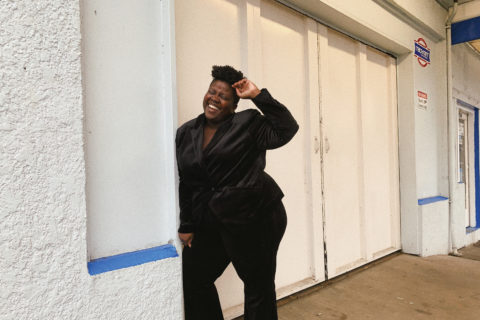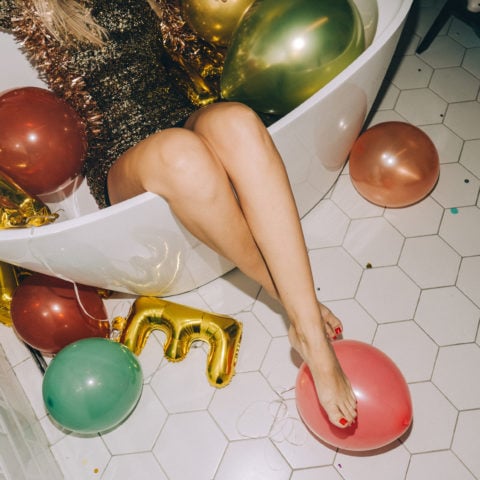Vancouver-based Writer Lydia Okello on the Future of Fashion They Would Like to See
Growing up in a conservative family, Lydia Okello favoured frou-frou frocks. But then their gender journey began.
“Oh. I guess I wear pants now….” It’s a seemingly unremarkable statement for someone to have made in 2016. But the notion was a major turning point that year for both my wardrobe choices and my gender identity. As an AFAB (assigned female at birth) person who grew up adoring frills, floofs and fanciful garments, I would never have been seen in a pair of pants, let alone jeans.
Looking back, it’s easy to see how my history shaped a narrowed view of how to clothe myself. I’m a first-generation Canadian-Ugandan who was raised in a conservative evangelical Christian home. Gender roles were rigid and in plain sight, and my penchant for frocks played right into my assignment as a young woman.
I often looked to 1990s pop culture for fashion inspiration. Utterly infatuated with sitcom protagonists, I pined after the clothes I saw on Family Matters, Saved by the Bell and Full House. D.J. Tanner’s tiered skirts always caught my eye; I also admired Uncle Jesse’s wardrobe but didn’t think too much of it. Watching Grease in the second grade, I was as much in love with Danny’s iconic greaser looks as I was with Sandy’s sock hop attire—two sides of expression, but at that time, I only consciously tended to one.
I awkwardly navigated my teen years in lace-trimmed tank tops and vintage skirts, questionably styled. I still held tightly to the perception that I needed to sustain “femininity”—though what feminine meant was a moving target.
As an adolescent bibliophile with lots of spare time in the summer, I pored over books about the golden age of Hollywood and the fashion industry’s heady past. I spent hours thumbing through reference size tomes of Christian Dior’s New Look and the history of Vogue and was entranced by Ken Russell’s images of postwar Teddy Girls; it was a foray into the fundamentals of fashion. I didn’t realize it then, but I was building a knowledge base that would eventually inform my career and my style.
I didn’t come out as a queer person until I was 25. I was scared, nervous and trepidatious. I wasn’t sure if I was even allowed to be queer. My limited perceptions of LGBTQ+ folks—who weren’t gay men—were based on gruff stereotypes, caricatures of people. As I came to accept my pansexuality, I loosened my grip on my high-femme personhood—for me, the two were intertwined. My internalized homophobia and transphobia meant that I had a very specific script of who I was permitted to be. Coming out allotted some breathing room in ways I didn’t expect. There was self-exploration of what it meant to be me: to be queer, to be Black. My plus size body no longer meant I had to be femme—it was something I could choose instead of be assigned to.
As I became more explorative in my identity, including being non-binary, I found myself seeking new inspirations and icons. Writer and performance artist Alok Vaid-Menon, whose style is composed of a mix of saturated hues and who rebels against gender “norms” in an unapologetic and fully realized vision of selfhood, and Héloïse Letissier, who fronts the band Christine and The Queens, are just a few of the folks who helped me unpack what I had previously considered to be limitations.
Vaid-Menon (and other nonconforming and non-binary people) has taught me to continually search outside the white gaze of gender expression as Black people, Indigenous people and other people of colour have pre-colonial histories of varied genders; I come back to that often. And Letissier reminds me that style—even extravagant or ostentatious style—is not limited to traditional concepts of femininity. She sports puff sleeves and ostentatious trousers, but neither fall into the territory of “feminine wiles.” Vintage infused and never demure, Letissier’s clothing choices hold space for frivolity—a fanciful nature that isn’t just reserved for ball gowns.
Today, I often tag my outfits on social media with #tombabe—a designation somewhere between “tomboy” and “babely.” I do it to make a statement that androgyny doesn’t have to be monochrome baggy pieces; it can mean a boldly hued sundress and badass boots. It can mean anything you damn well please. And that’s the future of fashion I want to see.
This story originally appeared in the September 2020 issue of FASHION Canada. Pick up your copy on newsstands now, via Apple News + or the FASHION app.








